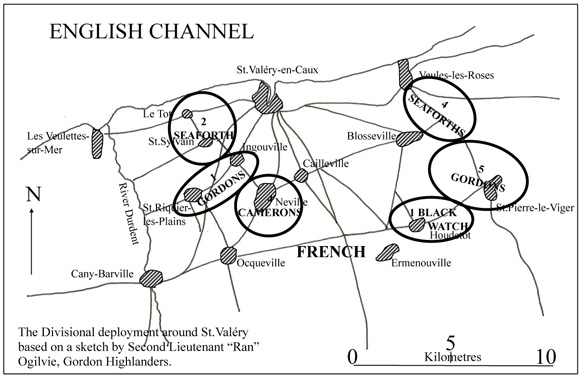
Part 5: Surrender at St. Valery.
Within a few hours of the dispatch of Ark Force, reports early on the morning of 10th June of the German advance made it apparent that the remainder of the Division was being cut off and the opportunity to evacuate through Le Havre was increasingly unlikely. General Fortune therefore decided to evacuate through St.Valéry-en-Caux. This news reached the Navy at 0400 hours on 10th June and preparation began.
St.Valéry-en-Caux was a small and far from ideal port for such an operation but there was no alterative.

Map of Dieppe – St. Valery
A box was drawn around the town with the 2nd Seaforths, 1st Gordons and 4th Camerons on the west side and 4th Seaforths, 5th Gordons and 1st Black Watch on the east side. The French were due to take up the bottom or south side of the box but until they arrived the Lothian’s, Norfolk’s and the 6th Battalion, Royal Scots Fusiliers (Pioneers) would cover the gap. The Division was in position early on the 11th June but the perimeter was never fully established.
The Germans, moving at great speed, were discovered by the Lothian and Border Horse in strength at Cany, to the west. The Germans pressed the line from the west along the coast and the south west. In the east the 4th Seaforths, 5th Gordons and 1st Black Watch were all in action.
General Fortune issued the following directive to commanding officers at 1000hrs on the 11th June:
“The Navy will probably make an effort to take us off by boat, perhaps to-night, perhaps in two nights. I wish all ranks to realise that this can only be achieved by the full co-operation of everyone. Men may have to walk five or six miles. The utmost discipline must prevail.
“Men will board the boats with equipment and carrying arms. Vehicles will be rendered useless without giving away what is being done. Carriers should be retained as the final rearguard. Routes back to the nearest highway should be reconnoitred and officers detailed as guides. Finally, if the enemy should attack before the whole force is evacuated, all ranks must realise that it is up to them to defeat them. He may attack with tanks, and we have quite a number of anti-tank guns behind. If the infantry can stop the enemy’s infantry, that is all that is required, while anti-tank guns and rifles inflict casualties on armoured fighting vehicles.”
During the afternoon of the 11th June the 1st Black Watch at St. Pierre-le-Viger came under great pressure from the Germans and by 1800hrs had lost some 50 men wounded or dead. They were supported by French cavalry who dismounted and, leaving their horse in a wood, fought as infantry. The position was finally overrun at dawn.
To the west the perimeter was penetrated and the 2nd Seaforths cut off in Le Tot. Without their anti tank platoon, which was on the other side of St Valéry, the enemy tanks were able to bypass them but not without loss. There were many fires in the town which was under constant bombardment from artillery and air attack. In the town the Divisional HQ, the 51st Anti-Tank regiment, part of the Norfolks and a Company of Kensingtons secured the perimeter. An attack into the town was repulsed in the late afternoon but the town was now surrounded. Final plans were now made for the evacuation, beaches allotted and orders given but these did not reach the 2nd Seaforths cut off in Le Tot.

Map of divisional deployment around St. Valery
After arriving in the harbour on the 10th and finding no one there the Navy had withdrawn on the 11th and after coming under air attack pulled further out to sea. When the order came to carry out the evacuation it was too late. A combination of fog obscuring the coast, the loss of several boats and the fact that the enemy occupied the cliffs overlooking the town made evacuation impossible.
Various local demands for surrender, specifically to 2ndSeaforths and 1st Gordons were robustly rebuffed. Preparations were made for a last resistance. Meanwhile the French capitulated at 0800hrs on the morning of the 12th June.
General Fortune considered all the options, a counter attack, further resistance, retaking the town but against this there was no possibility of evacuation or support, the men were exhausted and virtually out of ammunition, with no artillery ammunition at all. Shortly before 1000hrs on the 12th June General fortune took the most difficult of decisions – to surrender.
Coming soon………….Part 6: Bolt Action early war forces.
